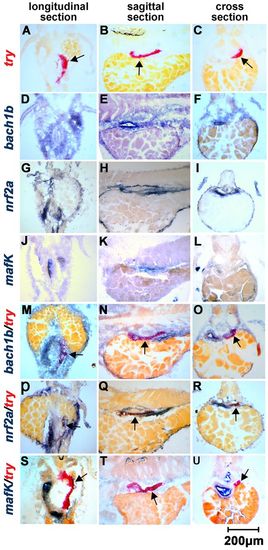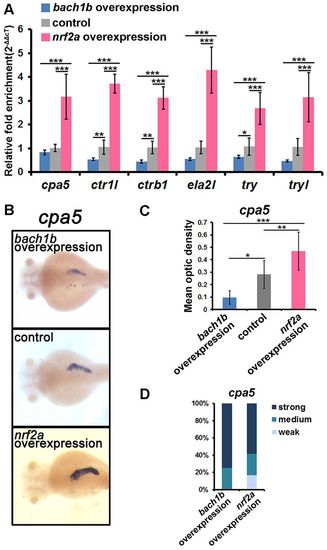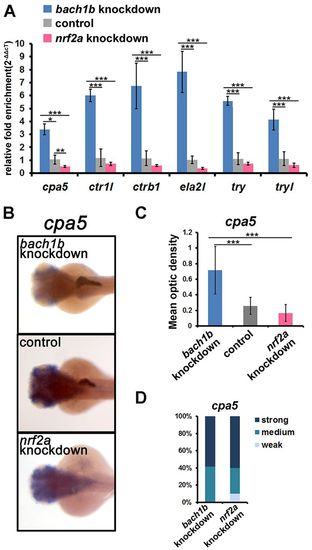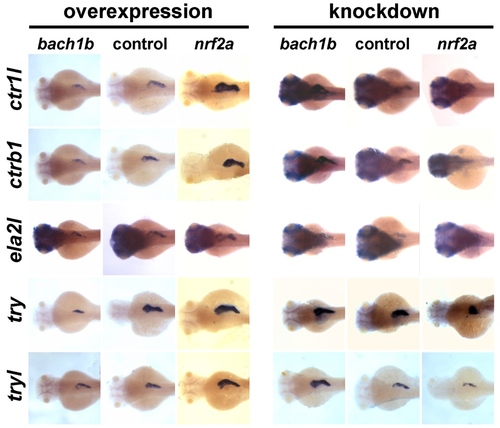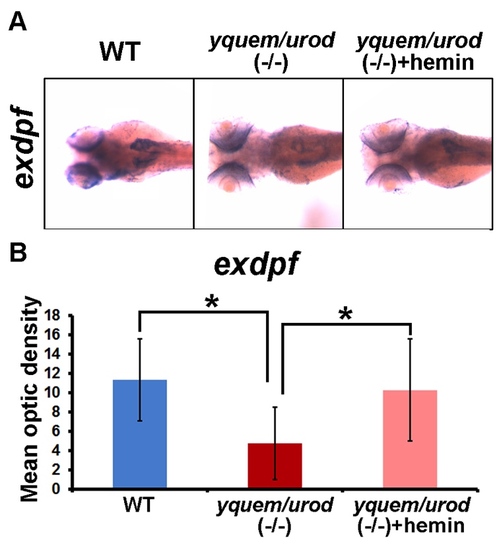- Title
-
Heme acts through the Bach1b/Nrf2a-MafK pathway to regulate exocrine peptidase precursor genes in porphyric zebrafish
- Authors
- Zhang, S., Xu, M., Huang, J., Tang, L., Zhang, Y., Wu, J., Lin, S., and Wang, H.
- Source
- Full text @ Dis. Model. Mech.
|
Expression of bach1b, nrf2a and mafK in the exocrine pancreas as shown by using double in situ hybridization. The fluorescein-labeled probe indicated the expression areas (red) of try, an exocrine pancreas marker (A,B,C). Digoxigenin-labeled probes indicated the expression areas (blue) of bach1b (D,E,F), nrf2a (G,H,I) and mafK (J,K,L). The colocalization of try with bach1b (M,N,O), nrf2a (P,Q,R), or mafK (S,T,U) in the exocrine pancreas was shown by using double in situ hybridization. Longitudinal sections are shown in A,D,G,J,M,P,S; sagittal sections are shown in B,E,H,K,N,Q,T; and cross-sections are shown in C,F,I,L,O,R,U. All larvae examined were at 84 hpf. Arrows indicate the exocrine pancreas. EXPRESSION / LABELING:
|
|
Overexpression experiments with bach1b and nrf2a reveal their antagonism in the regulation of zymogen expression. (A) qRT-PCR analysis showed that bach1b overexpression resulted in the downregulation of six peptidase precursor genes – cpa5, ctr1l, ctrb1, ela2l, try and tryl – whereas nrf2a overexpression resulted in their upregulation. Overexpression experiments were performed by microinjecting bach1b or nrf2a capped mRNAs into one-cell stage embryos. The expression levels of the six peptidase precursor genes in the microinjected and control larvae at 84 hpf were determined by qRT-PCR analysis. (B) Representative images of in situ hybridization staining show that downregulation of cpa5 resulted from bach1b overexpression and that its upregulation resulted from nrf2a overexpression, both specifically in the exocrine pancreas. Dorsal view, anterior to the left. (C) Mean optic densities of in situ hybridization staining of a group of larvae (10–12 each) corresponding to Fig. 3B were quantified by using ImageJ. (D) cpa5 morphant phenotypes. For individual larvae (84 hpf) of the bach1b overexpression group, the optic density values lower than the mean optic density value of its own group were marked as ‘strong’, and the optic density values higher than the mean optic density of the control group were marked as ‘weak’. For individual larvae of the nrf2a overexpression group, the optic density values higher than the mean optic density value of its own group were marked as ‘strong’, the optic density values lower than the mean optic density of the control group were marked as ‘weak’, and the values of optic density between ‘weak’ and ‘strong’ marked as ‘medium’. The statistical significance of difference between means was determined by one-way ANOVA and Tukey’s multiple comparison test (n=9) by using SPSS10.0.1. *P<0.05, **P<0.01, ***P<0.001. EXPRESSION / LABELING:
|
|
Knockdown experiments with bach1b and nrf2a reveal their antagonism in the regulation of zymogen expression. (A) qRT-PCR analysis showed that bach1b knockdown results in the upregulation of the six peptidase precursor genes that we examined, whereas nrf2a knockdown resulted in their downregulation. Knockdown experiments were performed by microinjecting MOs that targeted bach1b or nrf2a into one-cell stage embryos. For bach1b knockdown experiments, an ATG MO and SPL MO were used. Reverse transcription PCR showed that the SPL MO effectively altered bach1b intron 2 splicing (supplementary material Fig. S1A,B). The ATG MO also effectively knocked down bach1b (supplementary material Fig. S1C). The results using the SPL MO are shown here. For nrf2a knockdown experiments, we used an ATG MO, of which the efficacy of knockdown has been confirmed previously (Kobayashi et al., 2002; Kobayashi et al., 2009; Wang and Gallagher, 2013). The expression levels of the six peptidase precursor genes in the microinjected and control larvae at 84 hpf were determined by using qRT-PCR. (B) Representative images of in situ hybridization staining show that the upregulation of cpa5 resulted from bach1b knockdown and that its downregulation resulted from nrf2a knockdown, both results occurred specifically in the exocrine pancreas. Dorsal view, anterior to the left. (C) Mean optic densities of in situ hybridization staining of a group of larvae (10–12 each) corresponding to Fig. 4C were quantified by using ImageJ. (D) cpa5 morphant phenotypes. For individual larvae (84 hpf) of the bach1b knockdown overexpression group, the optic density values higher than the mean optic density value of its own group were marked as ‘strong’, and the optic density values lower than the mean optic density of the control group were marked as ‘weak’. For individual larvae of the nrf2a knockdown group, the optic density values lower than the mean optic density value of its own group were marked as ‘strong’, the optic density values higher than the mean optic density of the control group were marked as ‘weak’, and the values of optic density between ‘weak’ and ‘strong’ were marked as ‘medium’. The statistical significance of difference between means was determined by using one-way ANOVA and Tukey’s multiple comparison test (n=9) with SPSS10.0.1. *P<0.05, **P<0.01, ***P<0.001. EXPRESSION / LABELING:
|
|
Exocrine pancreas-specific downregulation or upregulation of ctr1l, 69 ctrb1, ela2l, try and tryl resulted from overexpression or knockdown of bach1b 70 and nrf2a, revealed by in situ hybridization. Representative images of in situ 71 hybridization staining show that upregulation or downregulation of ctr1l, ctrb1, ela2l, 72 try and tryl specifically in the zebrafish exocrine pancreas. Downregulation of ctr1l, 73 ctrb1, ela2l, try and tryl specifically in the exocrine pancreas resulted from bach1b 74 overexpression and nrf2a knockdown, and upregulation of ctr1l, ctrb1, ela2l, try and 75 tryl specifically in the exocrine pancreas resulted from nrf2a overexpression and 76 bach1b knockdown. Dorsal view, anterior to left. All larvae were 84 HPF. EXPRESSION / LABELING:
|
|
(A) Representative images of in situ hybridization staining indicate 127 downregulation of exdpf in zebrafish yquem/urod (-/-). Despite the expression of 128 exdpf elsewhere in larvae, it is the exocrine pancreatic expression that is most affected 129 in the mutant fish. Dorsal view, anterior to left. (B) Mean optic densities of in situ 130 hybridization staining of a group of larvae (10-12 each) corresponding to Fig. S7A 131 quantified with ImageJ. Student’s t tests were conducted. * P<0.05. These in situ 132 hybridization results are consistent with the qRT-PCR results shown in Fig. 7B. All 133 larvae were at 84 HPF (hours postfertilization). EXPRESSION / LABELING:
|

